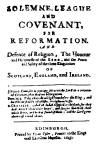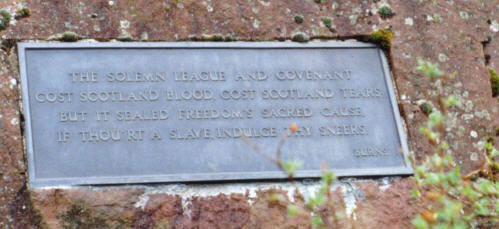|
Solemn League & Covenant 25
Sept 1643.
At the end of the Bishops`
Wars and the return of the English Long Parliament in
November 1640 there was a public dissatisfaction with the
bishops and episcopacy in the church. This gathered
momentum with the attempt to arrest the Five Members.
Subsequent to that a bill was passed that removed the
bishops from the House of Lords . In 1643 when the Civil
War had commenced Parliament passed ordinances that
abolished bishops, deans
and chapters . However, the organisation to replace
that of episcopacy was much more difficult as the English
had to placate
both the Scots who sought to extend Presbytery
throughout the three kingdoms, and the army who were much
more inclined to nonconformity that included religious
tolerance. In these circumstances there was little
prospect of a full blown Presbyterian system being
accepted right away.

Simply put the Solemn League
and Covenant of 1643 was a political agreement between the
English Parliamentary party and the Scottish
Presbyterians. For the Scots it was a religious covenant
with the ultimate aim of extending Presbyterianism as the
official faith in England and Ireland, and the extirpation
of Popery and Prelacy. For the Parliamentarians it was a
military treaty whereby the Scottish army would support
them against King Charles I in the English civil war that
had broken out. But as ever was the case, the different
interpretations of the Covenant would lead to division
among the parties.
The agreement came about
through an approach by the English Parliamentary party to
the Estates in Edinburgh and to the General Assembly in
August 1643 for a reciprocal military alliance. The
English Commission consisted of Sir William Armyn, Sir
Harry Vane (the younger), a Mr Hatcher, Mr Darley a Member
of Parliament, and two ministers Mr Stephen Marshall who
was Presbyterian and Philip Nye an Independent from the
Westminster Assembly of Divines. In the discussions the
Church of Scotland representatives, which included Robert
Blair, made it clear that it preferred a religious bond
and set Alexander Henderson, then the Moderator of the
General Assembly, to the task of drafting the document.
The English Parliamentarians
were unhappy with a clause that would have committed them
to reject episcopacy and also to take action against the
Independents or Congregationalists for which Oliver
Cromwell stood. There was moreover, a strong undercurrent
amongst the people of England for a form of episcopacy
founded on a tradition of 1500 years. There was also much
less objection to abolishing
the Laudian changes. This led to amendments that
left the door open for
the Independents in England phrasing the agreement
as :
…the reformation of
religion in the kingdomes of England and Ireland, in
doctrine, worship, and discipline, and Government
according to the word of GOD, and the example of the best
reformed churches
The
amendments were made and the document presented to and
approved by the General Assembly on 17 August 1643. At
this juncture the Estates made its price clear requiring
£30,000 a month for providing the forces and also three
months payment in advance.
The Solemn League and
Covenant was sent to London with Alexander Henderson,
George Gillespie, Mr Hatcher and Mr Nye to be approved and
subscribed to by the House of Commons and the Westminster
Assembly in a joint meeting on 25 September 1643. After
this it was returned to Scotland to be subscribed and
sworn to by the Commission of the General Assembly and the
Committee of the Estates of the Scottish Parliament. It is
pertinent to note that only the Scots actually swore to
the document and thus were particularly held to it by
their conscience. The document was again sworn to in 1648
and 1649, and was subscribed to by Charles II at Speymouth in
1650, and finally on his coronation on New Years Day 1651.
In a separate treaty of 29
November 1643 the details of the arrangement were
confirmed. The Scots would provide an army of 18,000 foot,
2000 horsemen, 1000 dragoons and a train of artillery. The
English Parliament agreed to a subsidy of £30,000 a month
which was later increased to £31,000.
The trouble that the
Covenanters went to agreeing and publicising the Solemn
League and Covenant is quite remarkable, but also very
prudent for
it left no one in any doubt what it was they intended. The
General Assembly followed up the treaty, which was widely
sworn to by the people, by requiring ministers to report
anybody who disapproved or would not swear to the
Covenants. It also became a requirement to subscribe to
both covenants for very many public and semi public
duties. This for example included students entering
universities, even to persons taking the Holy Communion
for the first time. A consequence was that the acceptance
of the Covenants was debased as the people `s self
interest sought jobs, preferment and power. This is why
James Guthrie wrote in his The Causes of the Lords
Wrath against Scotland
about the ignorance people had as to the importance
of the Covenant, and the lack of sincerity by many who
swore to it.
J Vos in The Scottish Covenanters
points out that the requirement to swear to the Covenants
was a mistake and should have been a voluntary action. By
making it compulsory the zeal of the Covenanter leaders
exceeded their wisdom
because it unintentionally tempted many to accept
the Covenants in a dishonest, careless, or least implicit
way The
Independents remained in opposition to the extension of
Presbytery throughout 1644 which delayed the creation of
classes (courts) and later the adoption of the Directory
for public worship. A start was made with the division of
the Province of London into 12 classes
and foreshadowed the splitting of the counties into
Presbyteries. Progress then began to grind to halt as it
encountered a groundswell for an Erastian settlement and
constraints on the appointment and powers of elders.
Moreover, since the victory at Naseby there was no real
need for the Scottish Army and thus no underlying need to
agree with their wishes. Thus a half a loaf compromise was
adopted by the Scottish Commissioners with an effort to
implement in London. There is some evidence that the Scots Army was
deliberately sidelined – they were given no `marching orders`, and the
payment agreed upon witheld by Cromwell`s order.
Since 1645
when the New Model Army came into being, and
especially from 1647 onwards, Presbyterians either
resigned or were expelled from the army with most of its
officers being sectaries. Despite their wide range of
beliefs they were, however, united in championing
toleration. Thus the Scottish aspirations gradually
crumbled in the face of this major disagreement of
principle, and were dealt mortal blows by Cromwell`s subsequent
victories at Dunbar and Worcester.

Commemorated at the Biggar
Museum is the above quote made about the Solemn League and
Covenant. Robert Burns spoke in reply to sneering comments
about the sufferings of Scotland for conscience
which called the Solemn League and Covenant
fanatical and ridiculous. He retorted :
The Solemn League and Covenant
Cost Scotland blood – cost Scotland
tears:
But it seal`d Freedoms sacred cause –
If thou`rt a slave, indulge thy sneers.
18/07/2011
|